How to Optimize Your PPC Landing Pages for SEO: 11 Best Practices for Better Rank, Traffic and Leads
You create compelling ads, target the right audience, and watch leads flow in. But what happens when your PPC campaign ends? Does that traffic disappear too?
Well, it doesn’t have to.
What if I tell you that there is a way to transform this temporary campaign tool into a long-term lead-generation machine?
Curious to know?
The answer is: Landing page SEO.
Which leads us to the next question,
What is Landing Page SEO?
Landing page SEO is an optimization tactic, done to attract more relevant visitors from organic search. Its focus isn’t limited to conversions- It’s to ensure your valuable content gets discovered organically by the right people.
By strategically optimizing your landing page with best SEO practices, you can attract organic traffic from search engines – people actively looking for the information or solution you provide.
This increases the chance of them converting to your call to action. (Imagine: a steady stream of visitors, primed and ready to engage with your content, all thanks to the wonders of landing page SEO).
So, what makes a good landing page?
Elements of a Good Landing Page
The components of a high-performing landing page can be divided into two segments, one with a focus on conversion and one with a focus on SEO.
Conversion-Focused:
- Clear and compelling headlines & subheadings
- Engaging and crisp content
- Value proposition
- High-quality images or videos
- Testimonials and reviews
- Smooth navigation
- A strong call-to-action (CTA)
- User-friendly form fields
SEO-Focused:
- Relevant keywords
- Meta and Alt tags
- Fast loading speed
- Mobile Responsive
- Clear URL Structure
- Internal Linking
- Social Proof and Trust Signals
- Unique and Valuable Content
Now that you are aware of what elements should be optimized to create a high-performing landing page, it’s time to find out why you should be optimizing them in the first place.
Why Optimize Your PPC Landing Pages for SEO?
While PPC excels at generating immediate traffic and leads, it comes at a cost. You’re essentially paying for each click. SEO, on the other hand, is a long-term strategy that attracts organic traffic through search engines at zero cost.
This makes Landing page SEO one of the most cost-effective landing page optimization strategies.
So, what are these compelling benefits that make Landing page SEO a must-do in marketers’s list? Let’s check them out.
1. It helps increase the organic visibility, traffic, and leads
A well-structured landing page, optimized with relevant keywords, meta descriptions, and SEO best practices, can rank organically in search engine results pages (SERPs). This means even without running ads, your landing page can attract qualified leads and traffic.
2. It helps improve your quality score
Search engines reward relevant and user-friendly landing pages that cater to both user intent and SEO best practices. This helps them get a higher quality score from platforms like Google Ads, potentially leading to lower ad costs and better ad placement.
3. It gives you long-term value
Beyond the immediate traffic from PPC ads, an SEO-friendly landing page can continue to generate organic traffic and leads long after your PPC campaign ends, providing a long-term return on your investment.
4. It makes your brand more credible
Ranking organically for relevant keywords alongside your paid ads creates a stronger brand presence in SERPs. It strengthens your brand’s credibility and positions you as an authority in your industry as well as in the eyes of your potential customers.
How to Optimize PPC Landing Pages for SEO
A landing page is often the first interaction potential customers have with your brand. Optimizing these pages for search engines is not just about climbing the SERPs—it’s about creating a seamless and engaging user experience that aligns with their search intent.
Here are the 11 effective best practices that you need to keep in mind while doing landing page SEO optimization.
1. Use Relevant and Targeted Keywords
While doing landing page SEO, integrating relevant and targeted keywords is paramount for increasing its visibility and ranking on search engine results pages (SERPs).
Here are the steps to do the keyword optimization the right way-
1.1 Research
Utilize keyword research tools to find terms and phrases that align with your business, offerings, and target audience’s search intent.
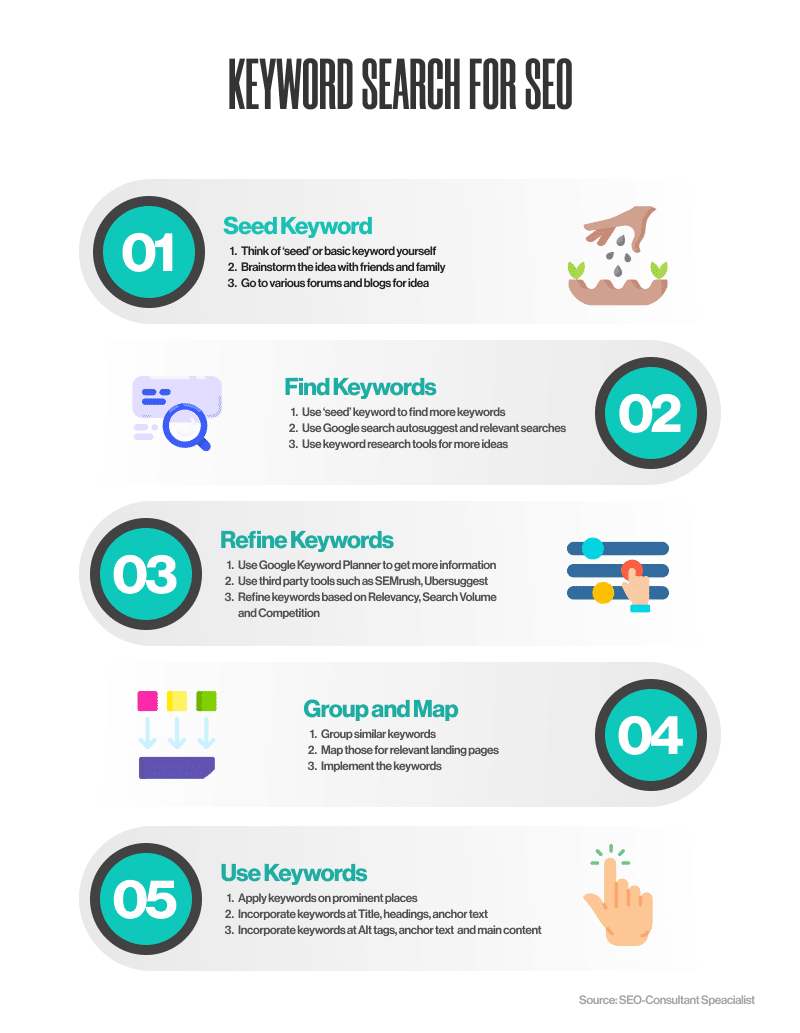
1.2 Strategic Placement
Strategically incorporate them throughout (without appearing forced or spammy of course), including the headline, subheadings, body copy, meta tags, and alt attributes for images.
1.3 Long-Tail Keywords
Consider using long-tail keywords to capture the attention of niche audiences and improve your chances of ranking higher for relevant search queries.
1.4 Stay Updated
Stay up-to-date with industry trends, shifts in consumer behavior, and changes in search engine algorithms to continually refine and update your keyword strategy.
2. Design for Search Intent
Search engines like Google prioritize delivering results that best satisfy the user’s query, making it essential for landing pages to align their content and design with search intent.
Here’s how you can sync your design with the search intent while doing landing page SEO:
2.1 Research Intent
Understand why users are searching for these keywords—is it to buy (transactional intent), to learn (informational intent), or to find a specific page (navigational intent)?
2.2 Content Relevance
Tailor your landing page content to meet the needs and expectations of users based on their search intent and provide them with valuable insights or specific solutions.
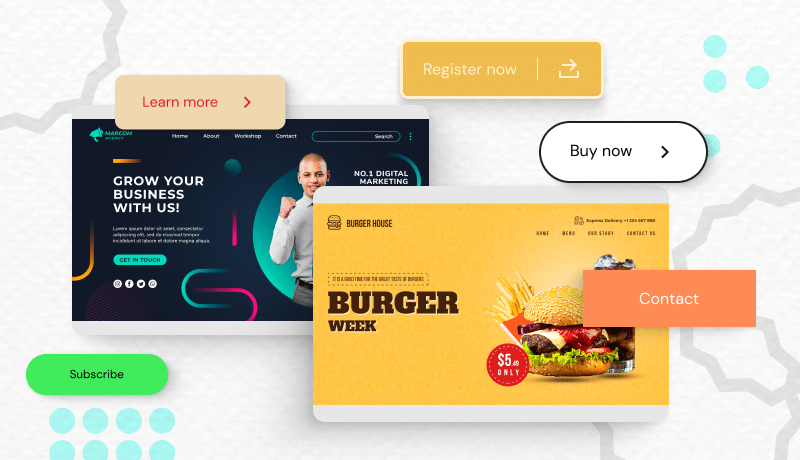
2.3 Design for Clarity
Ensure easy navigation and comprehension. Use clear headings, bullet points, and visual elements to break up the text and present information in a digestible format.
2.4 Match Design Elements to Intent
For example, for informational queries, prioritize clean layouts with easily scannable content, incorporating visuals such as infographics or charts to illustrate key points.
For transactional queries, emphasize prominent CTAs and streamlined checkout processes to facilitate conversions.
2.5 Visual Hierarchy
Place key information, such as headlines, benefits, and CTAs, at the top of the page to guide users’ attention towards the most important elements. Utilize contrasting colors, font sizes, and whitespace to create a clear and intuitive flow of information.
3. Optimize the On-Page SEO Elements
On-page SEO elements play a crucial role in landing page SEO as they determine the visibility and ranking of your landing pages in search engine results. By optimizing these elements, you can improve your page’s relevance, authority, and overall performance in organic search.
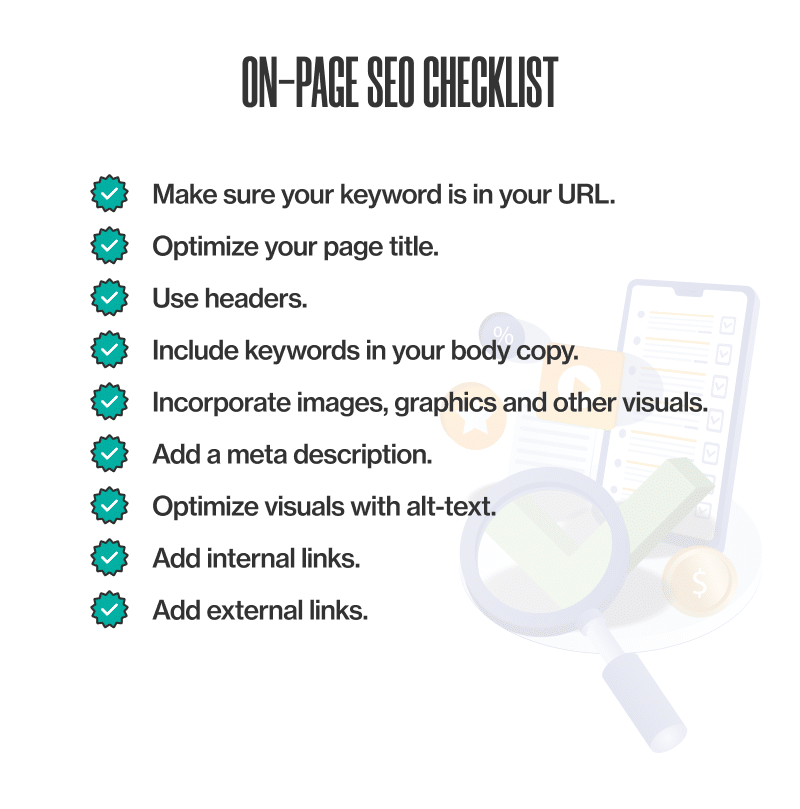
Here’s how to effectively optimize on-page SEO elements for your landing page SEO:
3.1 URL structure
Keep it concise, and include your target keyword. Avoid long, complex URLs with unnecessary parameters or session IDs, and instead, use human-readable URLs that accurately reflect the page content.
3.2 Meta description
Use strong keywords and tell users what they’ll gain by visiting your page. Remember, While meta descriptions don’t directly impact rankings, they are an important aspect of landing page SEO as they can influence click-through rates and user engagement.
3.3 Title and heading tags
Frame descriptive title tags that accurately represent the content and purpose of your landing page. Structure your content using heading tags (H1, H2, H3, etc.) to improve readability.
3.4 Image Optimization
Use descriptive file names and alt attributes that incorporate your target keyword and describe the image content. This will help improve the search ranking and accessibility.
3.5 Internal Linking
Add internal links within your content to connect related pages and distribute link equity throughout your site. To ensure context, use descriptive anchor text that includes relevant keywords.
4. Take the Length Into Consideration
When it comes to landing page SEO, rather than worrying about the length of the page, the focus should be on delivering relevant content that users need to make a decision.
Be it concise bullet points highlighting product features or a short, informative explanation of your service’s benefits.
Here’s why you shouldn’t fret about the length of your landing pages:
4.1 Quality Over Quantity
Instead of padding your landing page with unnecessary filler content to meet a specific word count, focus on delivering concise, informative, and engaging content that effectively communicates your message.
4.2 User Experience
Long-winded or verbose landing pages can overwhelm and deter users, leading to higher bounce rates and decreased engagement.
By keeping your content focused, clear, and to the point, you can create a positive user experience that encourages visitors to stay and explore further.
4.3 Attention Span
Keep in mind that a clear and concise landing page is more likely to keep users engaged. So, focus on crafting a strong headline, visuals, and CTA’s that guide users towards the desired action without unnecessary verbosity.
4.4 SEO Considerations
While longer content can potentially provide more opportunities for keyword optimization, it’s essential to strike a balance between depth of content and readability.
5. Add internal and external links
5.1 Internal Links
Guide users deeper into your website by linking to relevant content that expands on your landing page’s offer. This keeps users engaged, improves website navigation, and distributes SEO value across your website.
For example, a landing page for a new fitness tracker could link to a blog post with detailed workout routines using the tracker.
5.2 External Links
Establish credibility by linking to high-authority sources that support your claims. Linking to reputable websites demonstrates your expertise, strengthens your website’s authority in the eyes of search engines, and potentially improves your search ranking.
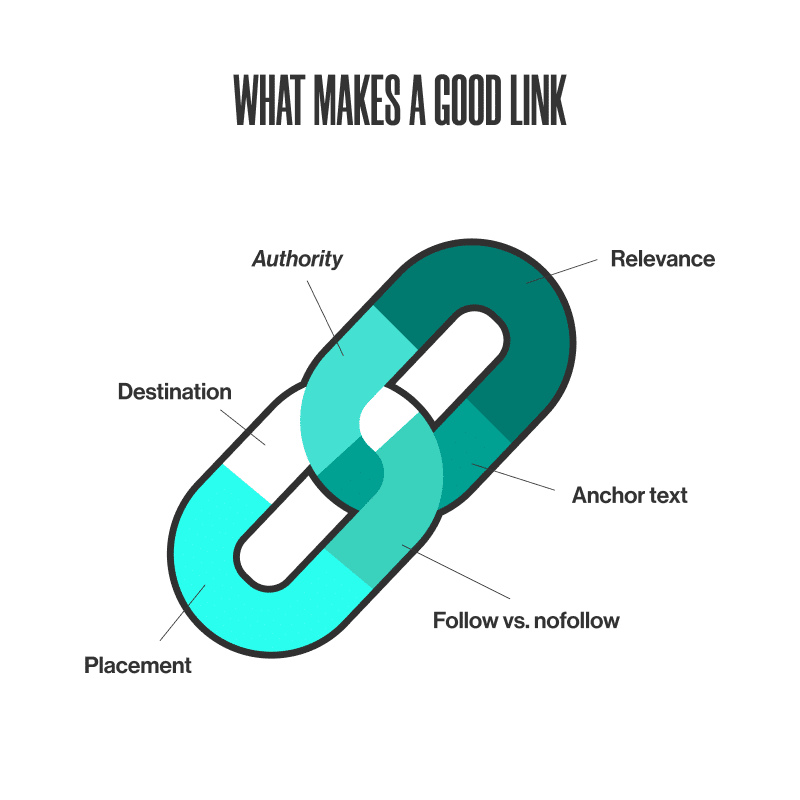
5.3 Link Diversity
When you are adding internal and external links while doing landing page SEO, aim for a diverse range of sources and anchor text. Avoid over-optimization by using natural, varied anchor text that accurately reflects the linked content.
Also read: 7 Link Building Strategies to Boost Your Off-Page SEO
6. Secure backlinks
Backlinks are essentially votes of confidence from other websites, making them an essential part of landing page SEO optimization. When high-authority websites link back to your landing page, it signals to search engines that your content is valuable and trustworthy.
This can not only improve your search ranking and organic traffic but can also boost your domain authority.
6.1 Link Diversity
While doing landing page SEO, avoid over-optimization and seek backlinks from a variety of websites within your industry, including blogs, forums, news sites, and authoritative publications.
Additionally, vary the anchor text used in backlinks to reflect the context of the linked content, rather than relying solely on keyword-rich anchor text.
6.2 Outreach and Relationship Building
Reach out to relevant bloggers, journalists, influencers, and websites. Identify opportunities for collaboration, guest blogging, expert interviews, or content partnerships that can lead to backlink opportunities.
6.3 Monitor and Analyze
Identify lost or broken links, and analyze the overall health and quality of your backlink profile. Disavow any low-quality or spammy backlinks that could harm your site’s reputation or rankings.
7. Use schema markup
The reason why this has earned a place in our list of landing page SEO best practices is due to the fact that schema markup is a way to provide search engines with additional information about the specific content on your landing page.
This can help search engines better understand your page and potentially improve your search result snippets, making your landing page stand out in SERPs.
There are various schema markup options available; identify the most relevant one for your landing page content.
Recommended Read: What is Schema Markup, Its SEO Benefits, and How to Implement it?
8. Optimize for Page Speed and Core Web Vitals
The average website load time is 2.5 seconds on desktop and 8.6 seconds on mobile. This means that optimizing your landing page for speed is a must.
Here’s how you effectively manage your landing page SEO for page speed and Core Web Vitals:
8.1 Minimize Server Response Time
Select a web hosting provider that is reliable and can provide fast server response times. Enable caching mechanisms such as browser caching and server-side caching to reduce server response times.
8.2 Optimize Images
Compress and resize images to reduce file size without compromising the quality of the images. Use modern image formats such as WebP to achieve better compression ratios.
8.3 Optimize Fonts
Consider using font-display: swap; to display text using system fonts while custom fonts are loading. Limit the number of font weights and styles to reduce font file size and loading times.
8.4 Address Core Web Vitals Metrics
- Largest Contentful Paint (LCP): Optimize server response times, render times, and resource load times to achieve an LCP of under 2.5 seconds.
- First Input Delay (FID): Minimize JavaScript execution time and prioritize critical rendering paths to achieve an FID of under 100 milliseconds.
- Cumulative Layout Shift (CLS): Avoid sudden layout shifts by specifying image dimensions, reserving space for ads, and using CSS animations responsibly.
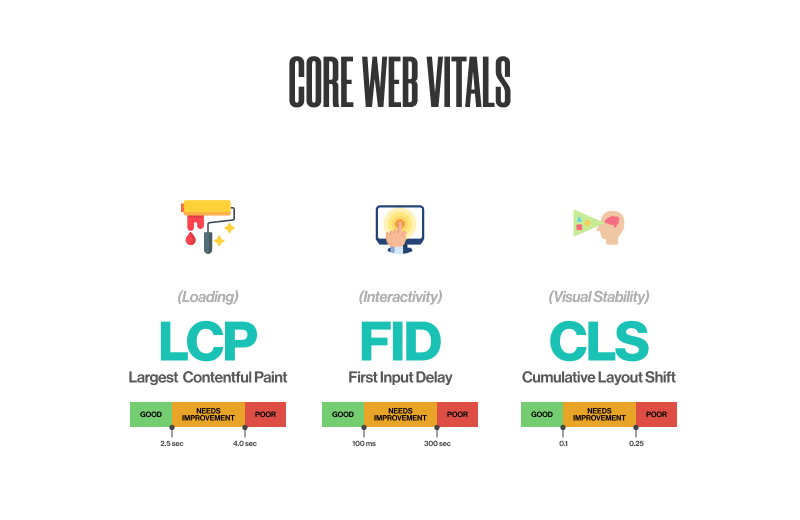
Use tools like Google’s PageSpeed Insights to analyze and improve your page’s loading time and overall performance.
9. Make Sure It’s Mobile-Friendly
With the increasing prevalence of mobile browsing, ensuring that your landing pages are mobile-friendly is essential.
Here’s how to ensure that your landing page SEO is being done right for mobile devices:
9.1 Responsive Design
Implement responsive web design techniques. Use fluid grids, flexible images, and CSS media queries to adjust the layout and content of your landing pages based on the user’s device.
9.2 Mobile-Friendly Navigation
Simplify navigation menus and buttons to make them easy to tap and navigate on touchscreens. Use a hamburger menu or collapsible navigation to conserve screen space and prioritize essential content.
9.3 Optimized Content
Optimize text size and spacing to ensure readability without requiring users to zoom in. Use concise and scannable content with clear headings, bullet points, and short paragraphs.
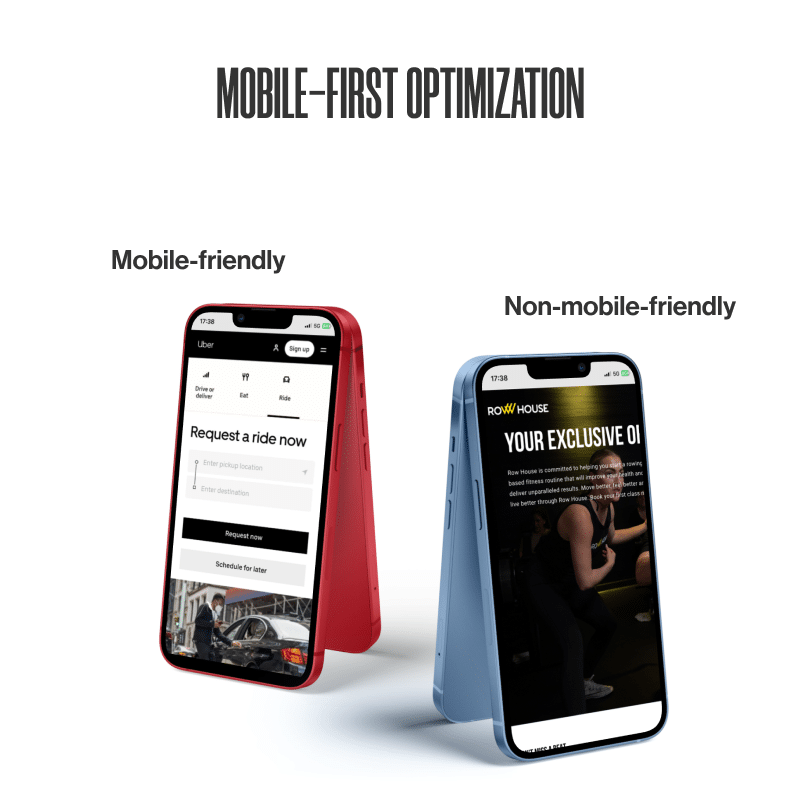
9.4 Fast Loading Times
Optimize images, scripts, and other resources to minimize page load times on mobile devices, where network speeds may be slower.
9.5 Touch-Friendly Elements
Use touch-friendly design patterns such as larger tap targets and ample whitespace to prevent accidental clicks and improve user interaction.
9.6 Mobile-Specific Features
Use mobile-specific features such as geolocation, device orientation, and camera access to enhance the functionality and user experience of your landing pages.
10. Add Social Proof and Testimonials
For effective landing page SEO, social proof and testimonials are powerful psychological triggers that can significantly influence the purchasing decisions of potential customers. According to statistics, sites with customer reviews see a 67% higher eCommerce conversion rate.
Here’s how to effectively leverage social proof and testimonials on your landing pages:
10.1 Customer Testimonials
Feature authentic testimonials from satisfied customers who have used your products or services and achieved positive outcomes.
10.2 Case Studies
Showcase in-depth case studies or success stories that demonstrate how your products or services have helped solve specific problems or meet the needs of your target audience.
10.3 Social Media Mentions
Display social media mentions, likes, shares, and comments related to your brand or offerings to showcase social proof and engagement. Encourage your visitors to follow you on your social media channels and engage with your content.
10.4 User Reviews and Ratings
Integrate user reviews and ratings from reputable review platforms. Respond to user reviews, whether positive or negative, in a timely and professional manner to demonstrate your commitment to customer satisfaction.
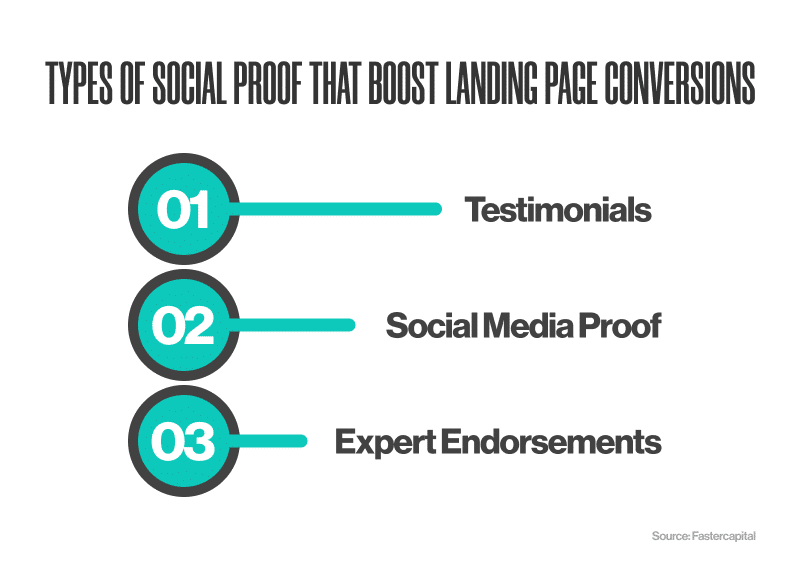
10.5 Influencer Endorsements
Collaborate with influencers to create sponsored content, product reviews, or sponsored posts that highlight the benefits and features of your offerings.
10.6 Trust Seals and Certifications
Display trust seals, security badges, or certifications from reputable organizations. Highlight any industry awards, accolades, or certifications that your brand has received to establish authority and credibility within your niche.
Suggested Read: How to Create a Winning SEO Strategy for Your Business
11. Create ‘Evergreen’ Landing Pages
Unless your offer is strictly time-bound (e.g., a holiday promotion), consider keeping your landing page active throughout the year.
Here are two approaches to maximize its effectiveness with the aid of Landing page SEO:
11.1 For Seasonal Promotions
Update the content to reflect the current season while maintaining the core value proposition. This allows you to leverage existing SEO value and avoid starting from scratch for each promotional cycle.
11.2 For Long-Term Offers
Create “evergreen” content that remains relevant year-round. Focus on topics with consistent search volume and user interest, ensuring your landing page SEO continues to attract organic traffic and generate leads.
Difference Between a Standard PPC Landing Page and One Optimized for SEO
A standard PPC landing page is often short-term and conversion-focused, while an SEO-optimized landing page is crafted with long-term traffic and organic ranking in mind.
While both aim for conversions, standard PPC landing pages and SEO-optimized landing pages have distinct goals and functionalities:
Standard PPC Landing Page:
- Typically designed for short-term campaigns aimed at driving immediate conversions.
- Emphasizes persuasive elements such as strong calls-to-action (CTAs) and compelling offers to encourage immediate action.
- Often focused on targeting specific keywords related to paid advertising campaigns.
- May prioritize design elements optimized for conversion, such as prominent forms or checkout buttons.
- May not prioritize organic search visibility or long-term SEO considerations.
- Content may be tailored more towards sales-driven messaging and may not prioritize informative or educational content.
- May not incorporate elements like schema markup or rich snippets.
SEO-Optimized Landing Page:
- Designed for long-term organic search visibility and attracting organic traffic.
- Emphasizes informative and valuable content aimed at answering user queries and providing solutions to their problems.
- Focuses on targeting relevant keywords based on comprehensive keyword research and search intent analysis.
- Prioritizes on-page SEO elements such as optimized meta tags, headers, and descriptive URLs.
- Incorporates elements like schema markup, rich snippets, and structured data to enhance search engine visibility and user experience.
- Content is often optimized for readability, user engagement, and shareability, aiming to attract natural backlinks and social signals.
- May include interactive elements, multimedia content, and internal linking strategies to improve user experience and SEO performance.
Also read: 25 SEO Tools You Should Be Using To Dominate The Web in 2024
When to Use Landing Page SEO Tactics?
Want to attract ongoing organic traffic, reduce reliance on paid ads, and establish a lasting presence in search results?
Here are the reasons that determine when should you use Landing page SEO tactics.
- When you want a landing page to generate leads and sales organically over time, SEO optimization is essential.
- When you want to reach users beyond those actively searching for your specific PPC keywords
- When you are looking for a sustainable and cost-effective source of traffic beyond paid advertising.
- When you want to go for multiple CTAs to cater to users who are ready to buy or simply want to learn more.
- When your landing page offers valuable content like guides, whitepapers, or educational resources.
- When building brand awareness and establishing yourself as an authority in your industry is a key goal.
What Does It Mean If Your Landing Page Isn’t Ranking?
If your landing page isn’t ranking, it could be due to:
- Poor keyword optimization.
- Low-quality content.
- Technical SEO issues.
- Insufficient or low-quality backlinks.
Bonus: Tips for Creating High-Converting Landing Pages
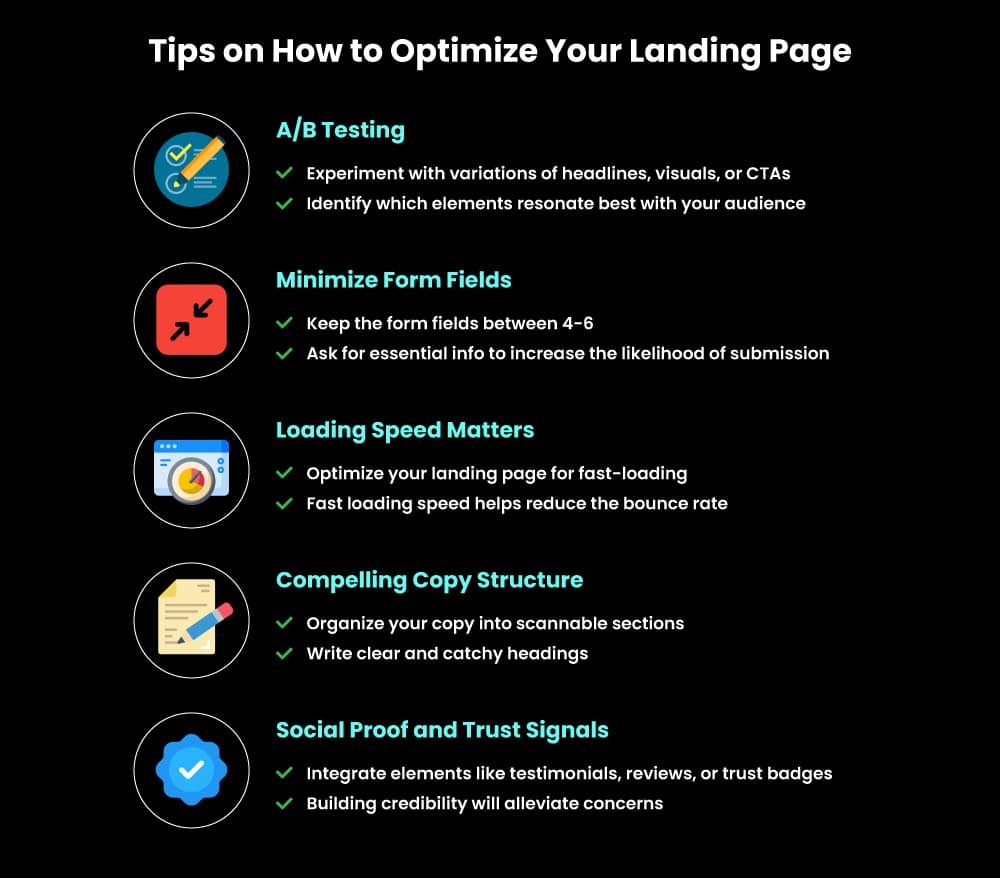
Conclusion
Landing page SEO optimization is a multifaceted approach that requires attention to detail, creativity, and strategic planning. By enhancing every aspect of your landing page for SEO, you can not only improve its search engine rankings but also its ability to convert visitors into loyal customers.
Remember, doing landing page SEO for your PPC landing page is an ongoing process.
By following the landing page SEO strategies outlined in this blog, businesses can create landing pages that not only meet the requirements of search engines but also provide valuable experiences for users, ultimately driving sustainable long-term growth.
Also read: 5 Effective Tips to Optimize Your Google Ads Campaign for Better Conversions


This post offers a fantastic guide on optimizing PPC landing pages for SEO! It clearly explains the benefits of SEO for PPC campaigns, along with a step-by-step approach to optimizing your landing pages.
I particularly liked the breakdown of the differences between standard PPC landing pages and SEO-optimized ones. It highlights the importance of creating informative content that caters to search intent, not just immediate conversions.
Excellent guide on optimizing PPC landing pages for SEO! Your 11 best practices provide clear and actionable steps to enhance both ranking and user experience. I found the tips on keyword integration, fast loading times, and mobile optimization particularly valuable. This post is a must-read for anyone looking to improve their digital marketing strategy. Thanks for the practical advice!
I do not even know how I ended up here but I thought this post was great I do not know who you are but certainly youre going to a famous blogger if you are not already Cheers
This post was very helpful and provided me with some great ideas. I’ll definitely be applying these tips.